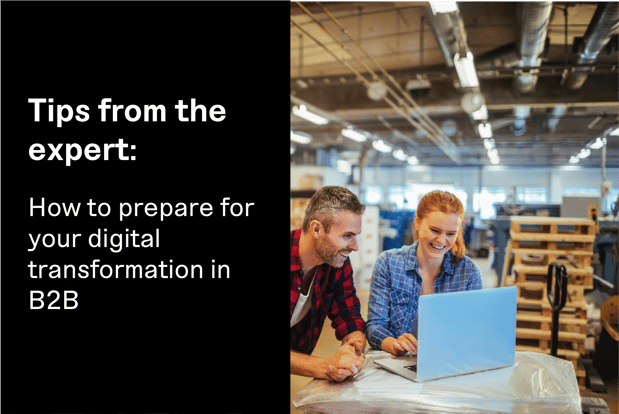Digital transformation in B2B is continuing to rise. The change needs to happen not only in technology structure but also in organizational, culture, processes, and skill sets. To make it work a shift in mindset and a willingness to adapt to the changes is needed for the organizations to be successful.
According to our study “Nordic Digital Commerce in B2B 2023” the respondents clearly stated that Digital sales investments drive organizational change:
📍 35% of respondents experienced changes in roles and responsibilities in operations.
📍 Nearly 23% of respondents gained increased customer needs and customer focus.
📍 19% say they have hired more employees and 7% say they have reduced staff.
Many companies stated that they realized the need to change. But change is hard… or is it?
To gain insights on change management during a digital transformation, we reached out to one of Sweden's leading experts in the field, David Ståhlberg.
About David Ståhlberg: David has during his years as an advisor, lecturer and speaker met with hundreds of organizations, advising them on questions relating to leadership, innovation and technology.David is currently the CEO of IT-consultancy firm Kvadrat and co-founder of the innovation hub Chapter X. David is an angel investor in several tech startups, has previously worked for both Procter & Gamble and Google and also served on the Board of Directors at Litium.
We aimed to gather his valuable tips and strategies for effectively navigating change management in the context of digital transformation in B2B.
What is your view of the transformation in digital commerce in B2B?
We are in the early beginning of a major shift in how B2B companies look at their offering and go to market. B2B companies used to focus on internal digitalization, such as production and backend process automation, and are therefore still lagging B2C companies in digitalization relating to the product offer itself and to the full customer journey, including marketing and sales.
B2B has due to higher specialization and sometimes more knowledge-intense buying processes been more of a relationship business. You wanted a human in the loop to explain things and tailor the solution to specific customer needs. But this has and will continue to change as digital product configuration and automated user support becomes more personalized and refined, not the least by integrating own user data and applying data models and AI to it.
So how can you prepare yourself for a successful transformation?
When working with a leadership team I often ask them to do two things as preparation.
- The first and most important is to spend time with the customer. Everything in business revolves around the paying customer. Tech is just means to an end. If old technology best serves her needs, we should use old tech. If new tech can unlock customer value, we should use new tech. So the job starts with uncovering those needs. This is very different from just asking the customer what they want. This is about truly understanding what the customer is trying to accomplish and what the pain points and opportunities are for them everyday on that journey.
- The second thing we do is to look at what the best and most forward looking companies in the world are doing. As inspiration. In your industry, in adjacent industries and also in totally different industries. When you combine deep customer understanding with a broad toolkit of inspiring examples you are in a brilliant position to start envisioning the future for your business. To explore solutions and improvements your customers are about to love, but would never think about themselves.
What tips do you want to give to decision makers in B2B for future success in their digital transformation?
To step up or step down. Either you insert yourself fully into the digitalization process - ideally you should be the engine of it - or, you will soon be too incompetent to remain CEO. We will continue to see rapid developments in tech, in process automation, digital sales and marketing, generative AI and robotics, to name a few important fields. Some of the best CEOs I have been working with have made it a personal priority to become more knowledgeable in decisive tech areas so that they can understand, and hence also lead others through, the developing business landscape.
What is the biggest mistake companies make when going into a transformation?
Many leadership teams are too short sighted. They do things here and now but lack both the strategies and the perseverance to make changes that truly sets them apart from competition. My goal is often to plan ahead for at least 5 years. What do we want our customers to say about us in 2030? What will our offer look like then that makes their life substantially better?
What changes do we have to make as a consequence? In our tech stack? In our abilities? In our organization? And then we make a road map. What do we have to accomplish year 1? Year 2-3? Year 4-5? Lasting change is not like running a 100 meter sprint. You do not have to be the fastest out of the blocks. It is more like a marathon. Pacing yourself over the long run, making steady progress and having the stamina and determination to stick to your plan.
Describe the future for Digital Commerce in B2B in one word.
Bright. 🔆
Thanks for all the valuable tips David. If you have questions for David or want to book him as a speaker or coach for your organization or leadership team, you can find him here on LinkedIn.
Are you ready to take the next step? Contact us for a discussion or a meeting.

